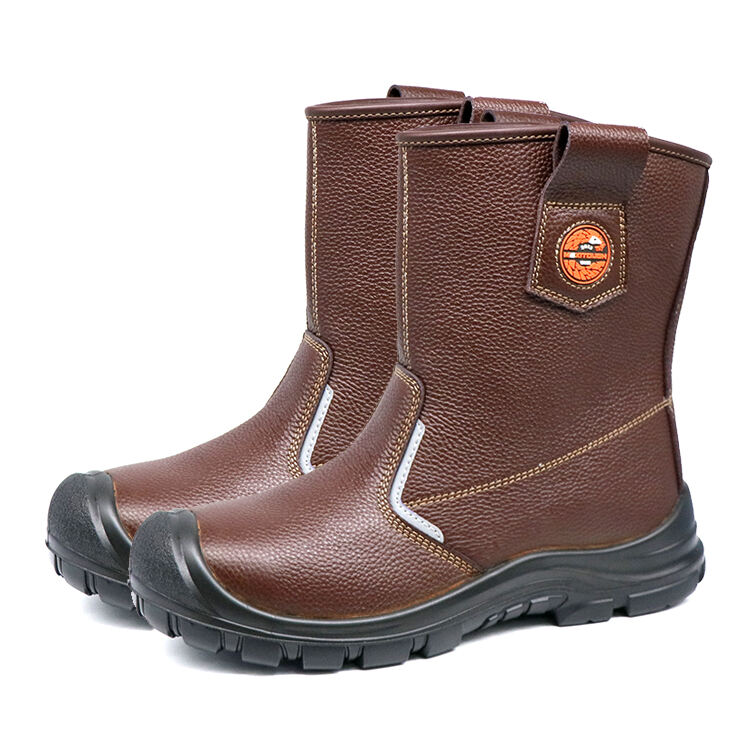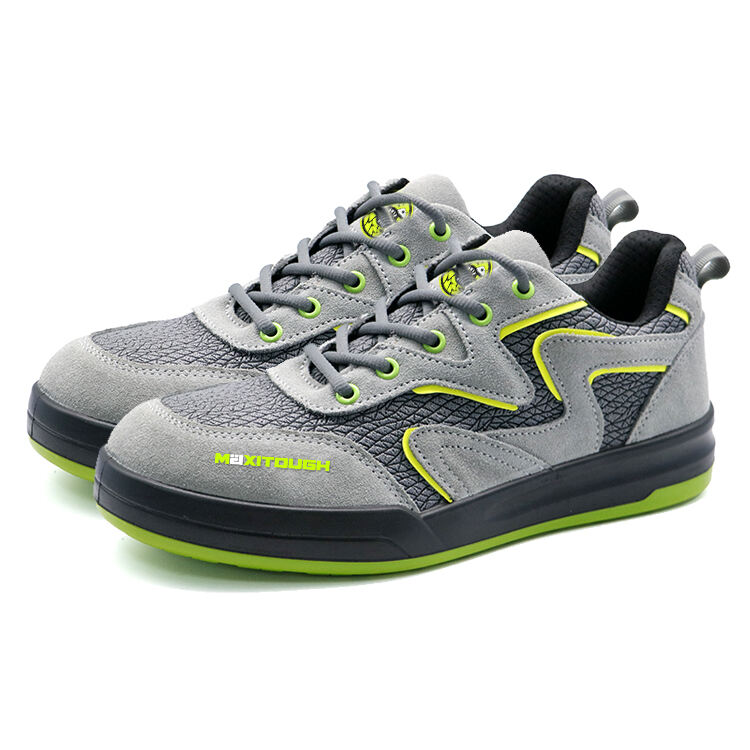
Key Features of High-Quality Safety Shoes for Industrial Use
Essential Safety Standards and Certifications
OSHA Compliance for Workplace Safety
Safety in the workplace is paramount, and the Occupational Safety and Health Administration (OSHA) establishes guidelines that prioritize worker safety and health. OSHA compliance is essential for employers to ensure that their workforce is protected against potential hazards, including those arising from improper footwear. Non-compliance with OSHA standards can lead to severe penalties and poses a significant risk to worker safety. According to the Bureau of Labor Statistics, there were over 5,300 worker fatalities in 2019 alone, highlighting the critical importance of adhering to these guidelines. One way to demonstrate compliance with OSHA standards is through safety shoe certifications, which ensure that the footwear meets specified safety requirements. Certified safety shoes, such as those offering waterproof protection or lightweight options, provide peace of mind and legal compliance for employers.
ASTM F2413-18 Impact and Compression Ratings
The ASTM F2413-18 standard is a significant benchmark in ensuring foot protection against workplace hazards. This standard specifies criteria for protective footwear, focusing on impact and compression resistance. It involves rigorous testing methods to ascertain the ability of safety shoes to withstand external forces that could cause harm. The importance of choosing the right ASTM-rated footwear based on specific work environments cannot be overstated. Industry experts emphasize that selecting shoes with appropriate ratings can significantly minimize injury risks on work sites, particularly for jobs requiring non-slip or waterproof features.
CSA Z195:14 Canadian Standards Explained
In Canada, the CSA Z195:14 standard plays a crucial role in setting high benchmarks for safety footwear. This standard ensures that safety shoes meet rigid specifications such as slip resistance and thermal insulation, catering to the diverse environmental challenges found in Canadian workplaces. For companies operating across the Canada-U.S. border, understanding and implementing these standards is vital to ensuring compatibility in safety measures. The CSA Z195:14 standard also underscores the importance of using safety footwear that is both versatile and responsive to specific on-site demands, making it an essential consideration for employers committed to maintaining rigorous safety protocols.
Durable Materials and Construction
High-Grade Leather vs. Synthetic Options
When choosing safety shoes, one of the key considerations is the type of material from which they are made. High-grade leather is often praised for its durability and comfort, providing excellent breathability that allows feet to stay comfortable over long working hours. On the other hand, synthetic materials can offer similar durability, often being more cost-effective and sometimes better suited to specific job environments. Research and consumer surveys show a preference split mostly based on job requirements; jobs demanding rugged wear might lean towards leather, whereas those in environments requiring lightweight shoes might prefer synthetic options. However, it's important to consider the environmental impacts; leather production involves significant resource use, while synthetic materials often involve plastic, posing their own ecological challenges.
Waterproof Safety Shoes for Wet Environments
Waterproof safety shoes play a critical role in protecting workers in wet environments, such as construction, oil and gas, and food services industries. These shoes are equipped with advanced waterproofing technologies, like membrane systems, which are highly effective in keeping feet dry even in the wettest conditions. Wearing waterproof safety shoes can significantly reduce workplace injuries by preventing slips and keeping feet dry. Statistics show a marked reduction in the slip-related workplace injury rate when waterproof footwear is properly utilized. These shoes do not just offer protection but also enhance worker productivity and morale by keeping feet comfortable throughout the workday.
Reinforced Toe Caps and Puncture-Resistant Soles
Reinforced toe caps are essential in safeguarding feet against impacts from heavy objects, making them indispensable in industrial settings. They offer vital protection, preventing injuries from falling tools or materials. Coupled with puncture-resistant soles, they provide a comprehensive safety solution. Statistics highlight the importance of these features by showing that foot injuries stemming from sharp objects are prevalent in workplaces like construction and manufacturing. Safety professionals always recommend assessing the specific risks of a worksite to choose the most suitable footwear, as the diverse designs and features of safety shoes mean that there's a perfect fit for every work environment, especially considering the potential hazards involved.
Advanced Protective Features
Non-Slip Safety Shoes for Hazardous Floors
Non-slip safety shoes are crucial for maintaining worker safety in environments prone to slips, such as kitchens or construction sites where spills are common. These shoes are designed to provide a sturdy grip, decreasing the chance of slip-and-fall incidents significantly. According to a study by the National Floor Safety Institute, slip and fall accidents account for more than 1 million hospital emergency room visits every year. Implementing high-quality non-slip footwear can greatly reduce these incidents. The effectiveness of these shoes largely depends on their tread patterns, which are expertly crafted to enhance traction on various surfaces. Opting for shoes with advanced grip technology can make all the difference in hazardous workplaces.
Electrical Hazard (EH) Protection
Electrical Hazard (EH) protection in safety footwear is vital for anyone working in environments where electrical exposure is a risk. EH-rated shoes are designed to protect against open circuits up to 600 volts in dry conditions, making them indispensable in electrical or industrial settings. These shoes undergo stringent certifications to ensure their effectiveness. Identifying such footwear is straightforward; they typically bear EH ratings on the label. Proper maintenance is essential to their effectiveness, such as checking for holes, as these can compromise electrical resistance. With the correct usage and upkeep, EH-rated shoes provide peace of mind in high-risk work environments.
Heat-Resistant Outsoles and Chemical Resistance
In industries like welding and metalworking, safety shoes need to protect against extreme heat. Heat-resistant outsoles are crafted to withstand high temperatures, safeguarding workers from burns. Additionally, chemical resistance is critical for individuals dealing with corrosive substances. This involves specialized shoe materials that repel oils, acids, and other harmful liquids commonly encountered in chemical plants or laboratories. Expert opinions suggest that investing in shoes with both heat and chemical-resistant properties ensures durability and optimal performance in challenging conditions. Regular inspection and maintenance of these shoes are recommended to sustain their protective qualities over time.
Comfort and Ergonomics for Long Shifts
Lightweight Safety Shoes for Reduced Fatigue
Lightweight safety shoes are a game-changer in improving mobility and reducing fatigue during long shifts. When workers spend extended hours on their feet, the weight of their footwear becomes a crucial factor. Studies indicate that lighter footwear contributes to lower fatigue rates, enhancing overall job performance and well-being. To find the best lightweight safety shoes tailored to individual needs, consider evaluating the shoe's weight, the materials used, and user reviews focusing on comfort during long periods of wear.
Breathable Linings and Moisture-Wicking Technology
Breathable linings and moisture-wicking technology play an essential role in foot health and comfort, particularly in demanding work environments. These features help in regulating temperature and moisture within the shoe, reducing the risk of blisters and infections. Experts recommend ensuring foot hygiene by selecting shoes made from materials such as mesh and synthetic fibers that promote airflow. By maintaining a dry environment inside the shoe, moisture-wicking technology prevents the accumulation of sweat, thereby enhancing comfort and foot health.
Cushioned Insoles and Arch Support Systems
Cushioned insoles are vital for absorbing shock and reducing impact on the feet, especially during long working hours. These insoles can significantly diminish the strain placed on the feet, preventing fatigue and discomfort. Furthermore, arch support systems are instrumental in preventing common foot ailments like plantar fasciitis, often encountered during long hours of standing. When seeking quality insoles, look for features such as high-density foam, anatomical design, and materials that provide excellent support. Emphasizing these attributes in safety footwear ensures comfort, reducing the adverse effects of long shifts on your feet.
Industry-Specific Design Considerations
Construction Site Requirements
Construction sites are fraught with potential hazards, making it essential for workers to have appropriate footwear. Safety shoes for construction sites must include critical features like toe protection to avoid injury from falling objects, and slip-resistant soles to maintain stability on challenging terrain. Footwear standards, such as ASTM and CSA, guide the specifications for construction safety shoes to prevent common job site accidents. For instance, the Canadian Centre for Occupational Health and Safety emphasizes choosing CSA-certified footwear to ensure comprehensive protection against impact, compression, and puncture hazards. By adhering to these guidelines, construction workers can minimize risks and maintain their safety on-site.
Manufacturing and Heavy Machinery Needs
In manufacturing and heavy machinery environments, safety footwear must withstand rigorous conditions. Safety shoes are essential for protecting workers from machinery hazards and falling objects frequently encountered in such industries. They often feature reinforced toes, slip-resistant soles, and durable materials to provide adequate protection. For instance, steel-toed or composite-toed shoes are recommended for maximum defense against compression injuries. Additionally, slip-resistant outsoles are crucial for maintaining footing on slick surfaces, common in manufacturing floors. By opting for industrial footwear that meets these needs, workers can significantly reduce the risk of workplace injuries while improving their comfort and productivity.
Oil & Gas Industry Safety Priorities
The oil and gas industry presents unique challenges that necessitate specialized safety footwear. Workers in this field often face extreme environmental conditions, such as high temperatures and chemical exposures, which require superior protective features in their shoes. Oil and slip-resistant outsoles are vital for navigating oily surfaces and preventing falls, while specialized materials can resist chemical damage. For example, footwear meeting standards like those from CSA for chemical protection can protect feet from hazardous substances. By selecting safety shoes with these tailored features, oil and gas workers ensure their safety and performance in demanding work environments.

 EN
EN
 AR
AR BG
BG HR
HR CS
CS DA
DA NL
NL FI
FI FR
FR DE
DE EL
EL HI
HI IT
IT JA
JA KO
KO NO
NO PL
PL RO
RO RU
RU ES
ES SV
SV TL
TL ID
ID SR
SR VI
VI HU
HU MT
MT TH
TH TR
TR AF
AF MS
MS GA
GA BN
BN NE
NE
